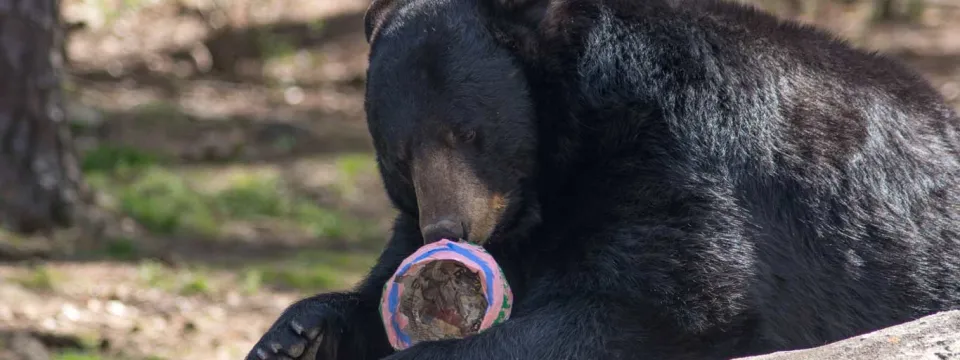Un-bear-ably Fun Research
Written by Kelly Bruno, Research Volunteer, North Carolina Zoo
I'm Kelly Bruno, and I'm studying Luna and Nova, 12-year old black bear sisters here at the North Carolina Zoo (Picture 1). Before I tell you about the exciting work I am doing here at the Zoo, let me tell you a little about myself!

Pictured Above: Nova (left) and Luna (right) enjoying a sunny day basking by their rocks! (Picture 1)
I hope to pursue a career in animal research, so the opportunity to study these bears is a wonderful stepping stone. I recently graduated from the University of North Carolina at Charlotte with a Bachelor of Science in psychology and a minor in biology. Before this, I did short behavioral studies on gibbons in Thailand and lemurs in Florida, but this is my first long-term animal behavior study. I hope to apply everything the Zoo is teaching me to study conservation biology in graduate school and eventually get my Ph.D. studying biodiversity hotspots.
Now, back to the bears! For some background: Black bears live in areas throughout North America. They weigh as little as 2 pounds at birth, then soar to a whopping 200 to 600 pounds as they grow. They are opportunistic eaters and omnivores, with a voracious appetite for nuts, fruit, grasses and occasional meat. Black bears must eat between 11 to 18 pounds of food per day to remain healthy! Black bears, therefore, must travel long distances (individuals can travel up to 15 miles a day!) to ensure they can gather up enough food to meet this massive diet requirement.
The Zoo encourages such natural behaviors in our bears to promote their wellbeing. This is through different forms of enrichment—items or changes that offer novelty and stimulation. Something as simple as food-filled paper towel rolls or scattering food across the habitat can engage the bears and elicit their wild counterparts' same natural behaviors (Picture 2). But how do we know what methods stimulate the most desirable behaviors? Scientific research offers an answer and serves as a vital tool to ensure the animals' welfare here at the Zoo.

Pictured Above: Nova spends time engaged with a paper mache egg filled with treats. This type of enrichment encourages her natural foraging behavior and promotes her wellbeing! (Picture 2)
My research project focuses on the effects of environmental variability (a form of enrichment) on the black bears. Specifically, I examine if "access" --the number of spaces in an enclosure available to an animal—is associated with an increase in desirable behaviors. The thinking behind this is that if we give them more areas to explore, we replicate the daily experience of wild bears, who travel long distances and experience varying environments (Picture 3). It is possible that offering a larger area to explore could increase their species-specific behaviors and ultimately improve their welfare.

Pictured Above: Luna goes for a walk, she travels and explores her large, natural habitat. (Picture 3)
At the Zoo, the large, naturalistic habitat you see as a guest is not the only area available to Luna and Nova. There are three other areas, behind the scenes, for the bears to explore. I have been observing the bears three days a week, for five hours at a time, and record their general behavioral activity. Two of these days, the bears have access to all areas, but for one of the days, they can only explore the front habitat (the one visible to guests). In this way, I can compare their behaviors on days they have access to days they do not and determine which scenario is associated with the more desired behavioral patterns.
Preliminary results show that by allowing increased choice over where they spend their time, Luna and Nova behave more like their wild counterparts! They spend more time engaging in desired behaviors, such as foraging and exploring, than the days where they have restricted access.
With this information, our animal care teams make informed management decisions designed to improve the animals' daily lives in their care. For Luna and Nova, because it is clear that environmental variability has positive effects on their behaviors, keepers will do their best to ensure they have as much access and variability as possible each day.
Research is a vital tool to help us understand the needs of animals here at the Zoo. Luna and Nova are fascinating, intelligent animals, and it is my privilege to work with the Zoo on their enrichment plan. When you visit the Zoo, you will likely see them foraging around their habitat just like bears in the wild.



